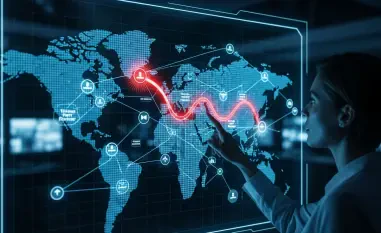In an era where global navigation satellite systems (GNSS) underpin nearly every facet of modern life, from guiding airplanes through crowded skies to ensuring farmers plant crops with precision, a shadowy threat looms large on the horizon, challenging the very foundation of our technological dependence. Electronic warfare (EW), with its arsenal of signal jamming and spoofing tactics, is disrupting GPS reliability on a scale never seen before. This isn’t just a military concern confined to battlefields; it’s a pervasive issue striking at the heart of civilian industries like aviation, agriculture, and finance. State actors, cybercriminals, and even natural phenomena are exploiting vulnerabilities in these systems, creating chaos that ripples across borders and economies. As incidents of interference skyrocket, the urgency to confront this invisible danger grows, raising critical questions about how society can safeguard the technology it depends on daily. The stakes couldn’t be higher as the world grapples with finding resilient solutions to protect vital infrastructure from these escalating disruptions.
Civilian Industries in Crisis
The reach of GNSS interference has expanded far beyond isolated conflict zones, infiltrating the daily operations of essential civilian sectors with alarming consequences. Aviation and maritime industries bear the brunt of this crisis, with over 122,000 flights disrupted in just the first four months of the year, according to recent data from SkAI Data Services. Pilots and ship captains face navigation challenges that threaten safety and delay critical shipments, undermining global trade networks. Beyond transportation, the agricultural sector is reeling, particularly in regions like Finland where farmers find their GNSS-dependent equipment rendered useless by signal jams originating from nearby Russian installations. This interference turns fertile fields into unfarmable land, jeopardizing food security. Even financial institutions aren’t immune, as GPS tracking for assets like ATMs becomes a weak point exploited by thieves, exposing a vulnerability that cuts across industries and demands immediate attention to prevent further economic fallout.
Compounding the problem is the sheer scale of dependency on GNSS technology, which has woven itself into the fabric of modern infrastructure without adequate safeguards. The disruptions aren’t just inconveniences; they pose real risks to safety and stability, as evidenced by the aviation sector’s struggle to maintain schedules and ensure passenger security amid spoofed signals. In agriculture, the inability to use precision farming tools hampers productivity at a time when global demand for food continues to rise. Meanwhile, financial systems face not only theft but also broader trust issues when location data can’t be relied upon for transactions or asset management. The ripple effects are profound, touching on everything from individual livelihoods to national economies. As these civilian sectors grapple with the fallout, it becomes clear that the problem of interference is not a distant threat but a present crisis, underscoring the urgent need for strategies to mitigate these disruptions before they spiral further out of control.
Geopolitical Tensions Driving Disruptions
At the core of GNSS interference lies a troubling geopolitical reality, where state actors weaponize electronic warfare to assert dominance or destabilize rivals. Nations like Russia and North Korea have been singled out by international bodies, including the United Nations civil aviation agency, for their widespread use of jamming and spoofing tactics. These disruptions are particularly acute near Russia’s borders with Europe and Ukraine, where signals are routinely scrambled, affecting not just military operations but civilian air travel and trade routes. Similarly, conflict zones such as Israel, Palestine, and Myanmar experience frequent interference, creating navigational hazards that complicate already tense situations. This deliberate meddling serves as a stark reminder of how electronic warfare extends beyond traditional combat, becoming a tool to exert influence over global connectivity and economic stability in regions critical to international relations.
The implications of state-sponsored interference stretch far beyond immediate geographical boundaries, impacting global networks that rely on seamless GNSS functionality. Airliners crossing these contested areas must contend with unreliable navigation data, leading to rerouting or delays that inflate operational costs and frustrate passengers. Maritime shipping, a backbone of international commerce, faces similar hurdles as vessels struggle to maintain accurate positioning in affected waters, risking collisions or missed deadlines. These actions by state actors are often timed with heightened political tensions or military maneuvers, amplifying their disruptive potential. The condemnation from global agencies highlights a growing frustration with such tactics, yet the persistence of these disruptions signals a deeper challenge: enforcing accountability in an arena where electronic attacks are hard to trace and harder to deter. Addressing this issue requires not just technological fixes but diplomatic efforts to curb the strategic use of interference.
Escalation Through Accessible Technology
A significant factor fueling the rise in GNSS disruptions is the alarming accessibility of interference technology, which has democratized the ability to wreak havoc on satellite signals. Daily incidents of jamming and spoofing have surged from roughly 700 last year to over 1,000 currently, driven by the availability of affordable devices that can block or falsify GPS data. As noted by Raphael Monstein of SkAI Data Services, the low cost of these tools has lowered the barrier to entry, enabling not just major powers but also smaller groups and individuals to engage in disruption. From large-scale military conflicts to localized disputes along borders like India-Pakistan or protests in Serbia, the landscape of actors capable of interfering with GNSS has expanded dramatically. This proliferation transforms what was once a specialized threat into a widespread problem that challenges global security frameworks.
The ease of acquiring jamming technology also means that the intent behind disruptions varies widely, complicating efforts to predict and counteract them. In some cases, interference serves as a tactical move in broader conflicts, disrupting enemy logistics or communication. In others, it’s a form of protest or sabotage by non-state actors seeking to make a statement or gain leverage in local disputes. The sheer volume of incidents strains the resources of agencies tasked with monitoring and mitigating these threats, as they must now contend with a fragmented array of perpetrators operating on different scales and motives. This escalation underscores a critical gap in current defenses: while GNSS systems were designed for reliability under normal conditions, they weren’t built to withstand such a pervasive and diverse onslaught. Developing countermeasures that can adapt to this evolving landscape of accessible interference technology remains a pressing priority for technologists and policymakers alike.
Criminal Exploitation of Signal Interference
Beyond the realm of state-driven electronic warfare, a darker trend has emerged as cybercriminals seize on GNSS interference to enable illicit activities. Thieves exploit jamming techniques to mask the location of stolen cargo containers, rendering tracking systems useless and frustrating law enforcement efforts to recover goods. This tactic has become a cornerstone of modern theft operations, allowing criminals to operate under a cloak of invisibility. Even more sophisticated schemes combine GPS spoofing with technologies like Voice over IP and synthetic identities to orchestrate supply chain fraud, deceiving companies and authorities alike. According to projections from the National Insurance Crime Bureau, the value of stolen cargo is expected to rise by 22% this year, illustrating how lucrative and pervasive these interference-enabled crimes have become in undermining economic security.
The criminal use of GNSS disruption adds a layer of complexity to an already daunting challenge, as it targets vulnerabilities in systems that businesses and governments rely on for trust and efficiency. Unlike state actors whose motives often align with geopolitical goals, these perpetrators are driven by financial gain, exploiting the same weaknesses for personal profit. The impact is felt across supply chains, where delays and losses erode confidence among stakeholders and inflate costs for consumers. Law enforcement agencies find themselves outpaced by the rapid adoption of interference tools among criminal networks, struggling to develop forensic methods to track and prosecute offenders. This growing trend highlights a critical need for industries to bolster their defenses with technologies resistant to tampering, while also pushing for stronger legal frameworks to address the intersection of cybercrime and electronic warfare in this evolving threat landscape.
Natural Threats Amplify GNSS Fragility
While human-induced interference dominates headlines, natural phenomena pose an equally formidable risk to GNSS reliability, exposing the fragility of systems society takes for granted. Solar activity, such as the intense flares recorded in May of last year, can disrupt satellite signals on a massive scale, with the potential to halt up to 70% of U.S. agricultural production during a prolonged outage. Such events serve as a stark reminder that vulnerabilities extend beyond deliberate attacks, encompassing environmental factors outside human control. Agriculture, heavily reliant on precise timing for planting and harvesting, faces catastrophic losses when signals fail, threatening food supply chains at a time when global populations are growing. This intersection of technology and nature underscores the precarious balance on which critical industries operate, amplifying the call for diversified navigation solutions.
The unpredictability of natural disruptions like solar flares complicates planning and mitigation efforts, as their occurrence and impact are harder to forecast than human actions. Unlike jamming or spoofing, which can sometimes be traced to specific actors or regions, solar events affect vast areas indiscriminately, challenging the resilience of GNSS infrastructure on a global scale. The agricultural sector’s vulnerability is particularly concerning, as extended outages could lead to widespread economic ripple effects, from higher food prices to supply shortages. Other industries, including telecommunications and emergency services, also suffer when timing data is lost, disrupting operations that depend on split-second accuracy. Addressing this dual threat of human and natural interference requires a broader approach, investing in backup systems that can function independently of satellite signals and withstand the full spectrum of risks that jeopardize connectivity in an interconnected world.
Building Resilience Through Innovation
In response to the mounting threats against GNSS, a chorus of experts and industry leaders is advocating for urgent innovation to secure navigation and timing capabilities. The current state of GPS vulnerability, as emphasized by figures like Todd Humphreys from the University of Texas, demands a shift toward hardening systems across aviation, maritime, and communication sectors. Promising technologies, such as gyroscopes-on-a-chip and laser-based navigation, are being explored as alternatives immune to traditional jamming and spoofing tactics. These advancements offer a glimpse of a future where critical infrastructure can operate without fear of signal loss, but their development and deployment require significant resources and coordination. The push for such solutions reflects a growing consensus that reliance on a single, fragile system is no longer tenable in the face of sophisticated electronic warfare.
Support for alternative positioning, navigation, and timing (PNT) systems is gaining traction among influential voices, including the GPS Innovation Alliance and industry advocates like Ed Bolen of the National Business Aviation Association. Their call for government investment underscores the scale of the challenge, as transitioning to new technologies involves not just technical hurdles but also policy and funding commitments. The benefits of such a shift are clear: diversified PNT systems could mitigate the impact of both deliberate interference and natural disruptions, ensuring continuity for industries that underpin global economies. However, the path forward is fraught with obstacles, from the high costs of research to the logistical complexities of retrofitting existing infrastructure. As threats continue to evolve, the race to implement these resilient solutions becomes a defining test of whether society can adapt quickly enough to protect the invisible networks that keep the world moving.













